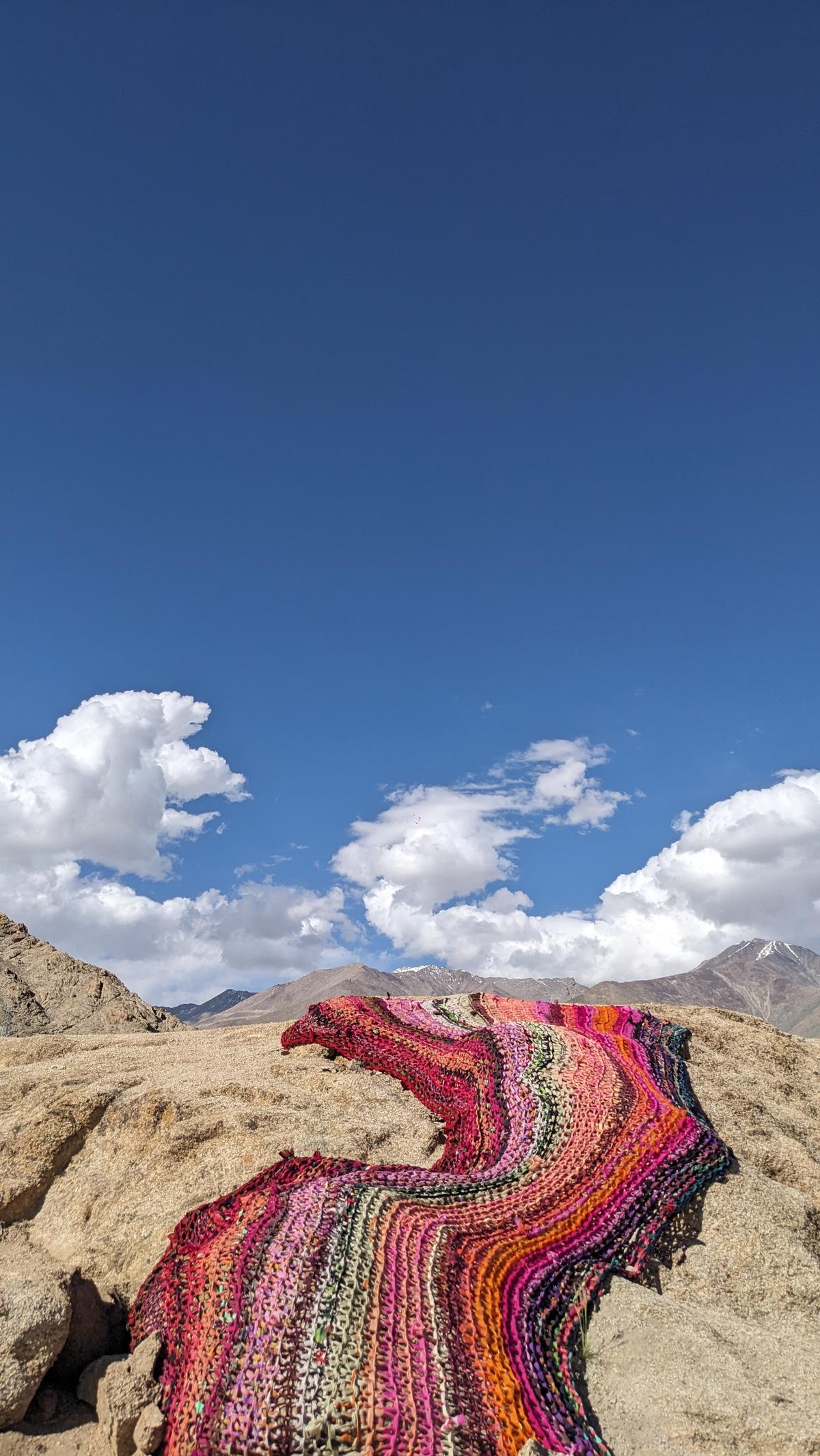A carpet of red, brown and maroon cloth stretches across a dirt road leading to a barren mountain range. Nearby, a cross-section of land glows in blue light at night. If the previous edition of Sa Ladakh, South Asia’s highest contemporary land art festival, is anything to go by, interactive public art in the country has found an effective format: imagine art at an altitude of 3,500 metres.
As you read this, bamboo poles, one of the tallest in the country, are being erected at the 22-acre Disco Valley Bike Park in Leh, and preparations for the festival are underway.
Here, Ladakh is not only the host but also the subject. This year’s edition, titled Immersive Land Art and the Future, hosts site-specific art installations and sculptures crafted from locally sourced, discarded and renewable materials with the active participation of the local community.
Conceptualised a year and a half ago by Ladakhi mountaineer Tenzing ‘Jamie’ Jamyang, Austrian-Sri Lankan interdisciplinary artist Raki Nikahetia and Indian spatial designer Sagardeep Singh, the festival is a result of their love for Ladakh and land art.

‘River of Sweat’ by Anshu Singh from the previous edition | Photo Credit: Special Arrangement
“We all had different reasons to love Ladakh. Jamyang is from here, Sagar worked here for a long time, and I grew up in the mountains in Austria and visited here often,” says Raki.
Initially, Sagardeep and Raki wanted to collaborate on a land art project within the bike park, and when they understood its scale, they decided to invite others as well.
“We wanted to do something about the environment, culture and community. We also started thinking about how we could involve as many Ladakhi artists as possible, and so the Ladakh Arts and Media Organisation got involved.” The group soon grew from three artists to 40. Being a platform that brings forth Ladakhi artists who rarely get exposure to the outdoors, the project also aims to draw international attention to climate change and awareness about it, not as activism but as “optimism”. “The aim is not to judge whether someone is doing the right thing or the wrong thing, but to adopt a collaborative approach among artists to respond to the changing environment,” explains Raki.

Therefore, the question of how one can live and create sustainability forms the basis of their work. The question before the artists was how they would imagine or connect with such a vast landscape in times of a changing environment. The 2024 edition includes works by renowned artists such as Manisha Gera Baswani, Kunzes Angmo, Tsetan Angmo, Zarina Parveen, Kundan Gyatso, Stanzin Tsepel, Tsering Udol, Urgain Zawa, Lee Actuali, Viola Borden, Doyle Joshi, Neel Ghosh Basler, Omaggio Performing Company, Margherita Moscardini, Raghav and Ansh Kumar, Angelina Kumar, Ramon De Marco, Ikshit Pandey, Jasmeet Dhillon and Laurent Ziegler.
Senior renowned artists like Minerva Cuevas, Shilpa Gupta, Samson Kambloo, Agnieszka Kurant, Christian Robert-Tissot, Eva Schlegel, Grazia Toderi and Erwin Wurm will also showcase their art works.
Untitled work from last edition by Jigmet Angmo | Photo courtesy: special arrangement
In an interesting collaboration with the Austrian public art institution, Museum in Progress, constantly changing and spreading flags at various locations within the space will track the movement of the wind. Another collaboration with Royal Enfield is an artist residency called The Himalayan Knot that will bring together Himalayan communities, local artisans and textile conservationists to preserve the pastoral land and its vibrant heritage by spreading awareness about Ladakh’s rich fibre culture. A major part of this year’s celebration hinges on school outreach programmes.
“It is a challenging landscape. The main physical challenge is the weather – strong sunlight, winds, snow, cloudbursts (which are happening frequently now). Sometimes, it is also about adapting to the situation and learning from local work. Sometimes, the artist comes with a concept, but it changes when it is put in place,” says Raki.
A big question with public art is what happens after it is made or displayed. Raki says each artist is asked to answer this question at the open call stage itself – “We look at how the artwork can go back to the community, for example, how reused wood can be used to construct a building. It can also be artwork that can go and be displayed somewhere else.” This is also the beauty of contemporary art, as it is without limits, which encourages each artist to think about the possibilities of the materials used. “The idea is what creates the magic within,” he says.
‘For a Fifty Million Years’ by Raki Nikahetia from a previous edition | Photo Credit: Special Arrangement
How do visitors prepare for this experience? Raki has a checklist. “You have to acclimatise yourself. 48 hours is ideal. Once you acclimatise yourself, bring good shoes, sunscreen, hat and water. It is a 45-minute walk from Leh to the bike park or a 10-minute road trip. The best time to visit is from 10am to lunch time. From 5pm to 6pm, there will be curated walks. It is both art and exercise!”
Ladakh will be open to the general public from June 1 to 11 at the Disco Valley Bike Park in Leh. School workshops will run from June 1 to 5. Entry is free for all.
